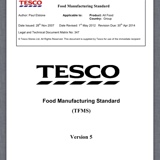Information
-
Document No.
-
Audit Title
-
Client / Site
-
Conducted on
-
Prepared by
-
Location
-
Personnel
27.1 - EQUIPMENT AND FACILITIES (BASE)
-
The structure and fabric of the buildings and equipment must be maintained in a good condition with repairs completed.
-
A system must be in place to prioritise repairs that may impact on food safety, legality and quality.
-
All repairs must be completed in agreed timescales
27.2 - PREVENTATIVE MAINTENANCE (BASE)
-
There must be a planned preventative maintenance (PPM) program that covers all equipment critical to safety, legality and quality, which is fully implemented
27.2.1 - PREVENTATIVE MAINTENANCE (ASPN)
-
A computer based risk assessed PPM programme is in place that details all equipment, highlights when activities are required and enables equipment history and trend information to be obtained
27.3 - RECORDS (BASE)
-
A system must be in place to record all maintenance work requested and PPM work completed
-
Work must be completed in the agreed timescales
-
Procedures must be in place to manage work not completed within agreed timescales
27.4 - FOREIGN BODY RISKS (BASE)
-
A system must be in place to identify and correct potential sources of foreign bodies or hygiene hazards e.g. Flaking paint, damaged surfaces
27.4.1 - TREND ANALYSIS (ASPN)
-
Trend analysis information is used for on going trend analysis to identify and act on areas for improvement
27.5 - EQUIPMENT (BASE)
-
Repairs to or servicing of equipment must be completed by trained engineers, approved contractors or the equipment manufacturer
27.6 - EQUIPMENT (BASE)
-
Engineering activities must be controlled
-
Risk assessments must be completed prior to work commencing to ensure product and packaging is not put at risk
27.7 - ENGINEERING (BASE)
-
Engineering work areas (including stores) must have good standards of fabrication, hygiene and housekeeping
-
The areas must be within the scope of the site Pest Control Programme
-
Production or food containers must not be used as general storage containers in these areas
27.7.1 - ENGINEERING (MEDIUM)
-
Wherever possible, engineering work must take place away from production areas
-
Engineering and maintenance areas that access directly into production areas must have restricted access
27.8 - ENGINEERING (BASE)
-
Welding, drilling, riveting and soldering etc. must not take place on equipment being used for production or on any equipment immediately adjacent , unless suitable hygienic screening is in place
27.9 - ENGINEERING (BASE)
-
Temporary repairs must be controlled to ensure product is not put at risk
-
The material used must be suitable e.g. No sticky tape.
-
Permanent repairs must be made promptly
27.10 - TOOLS (BASE)
-
Tools must be kept clean, well maintained and replaced when necessary
27.10.1 - TOOLS (MEDIUM)
-
Tools must be captive to site or adequately cleaned prior to transferring into open food areas
27.10.2 - TOOLS (HIGH)
-
Tools must be captive to high risk / high care areas or disinfected into the area
-
In the event of electrical items being required they must be clean and wrapped so that the item is waterproof, and then disinfected into the area
27.11 - TOOLS (BASE)
-
Engineers completing repairs in production areas must be provided with a lockable metal or plastic tool box
27.12 - TOOLS (BASE)
-
All tools and parts must be controlled.
-
A system must highlight and initiate an investigate if a tool or part is missing
27.12.1 - TOOL BOXES (MEDIUM)
-
Tool boxes must contain an inventory of items they contain
27.12.2 - TOOL BOXES (MEDIUM)
-
Tool box contents must be checked at a defined frequency against the inventory
-
All small items must be separately contained within the tool box
27.12.3 - PARTS (MEDIUM)
-
Whilst engineers work on production equipment, small parts must be stored in sealed marked containers, magnetic mats or trays to reduce the risk of product contamination
27.13 - ENGINEERS / CONTRACTORS (BASE)
-
Engineers and contractors must comply with necessary health and safety requirements and operational GMP of huge site, including wearing of protective clothing
-
A list of approved contractors who have been briefed on site controls must be in place
27.13.1 - ENGINEERING (MEDIUM)
-
A permit to work system must be in operation if the maintenance work required poses a potential risk to product (e.g. Welding, cutting etc.) or individuals e.g. In Confined spaces.
27.14 - ENGINEERING (BASE)
-
After engineering work (including temporary repairs) has been completed, a system must be in place to assess cleaning requirements prior to use in production
-
Where cleaning is required following maintenance, this must be undertaken before production commences and must be recorded
-
Equipment must be checked and signed back to production by the engineer following work and necessary cleaning
27.15 - ENGINEERING (BASE)
-
Only food grade lubricants may be used on food handling / contact equipment.
-
Information must be available to demonstrate food grade suitability for materials used
-
Food and non food lubricants are stored separately
-
Lubricating equipment is dedicated to food or non-food lubricants














